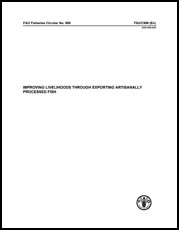|
Diei-Ouadi, Y.; Mensah, M.E.
Improving livelihoods through
exporting artisanally processed fish.
FAO Fisheries Circular. No. 998.
Rome, FAO. 2005. 35p.
ABSTRACT
A study was carried on the export of traditional African
fishery products to "ethnic" markets in the European Union, United States and
Canada. The study was conducted in Côte d’Ivoire and Ghana and
covered export plants, their suppliers, the competent authorities for sanitary
certification, the fisheries departments, export promotion councils, and other
stakeholders.
The main export-oriented traditional fish products identified
were smoke-dried fish and shrimps, sun-dried fish and live crabs. In both
countries the socio-economic importance of traditional fish processing and
export operations is considerably higher than indicated by official statistics,
contributing to incomes of artisanal fishermen and women fish processors,
incomes of small-scale fish exporters, employment, and foreign exchange
earnings. Also the contribution to responsible fisheries was
underestimated.
There are indications of unsatisfied demand but further growth
of the sub-sector would depend on overcoming certain weaknesses identified by
the study, such as weaknesses of competent authorities in effectively enforcing
regulations, limited knowledge by operators of the sanitary regulations, misuse
in some cases of registration numbers and inclusion of products from
non-registered producers in consignments from registered ones, police
harassments, low awareness among authorities of the importance of the trade, and
lack of organization within the sub-sector. Also, the design of the facilities
and of the smoking operations themselves seemed rather wasteful of fuel
wood.
As a direct result of the study, authorities already committed
themselves in reviewing the certification process in order to address its
cumbersomeness and match the quality assurance systems with the rationale and
systematic approach within the global sanitary concept; to deploy staff to exit
points; and to improve relations with operators and providing them more advisory
services.
They moreover confirmed the need for an in-depth study of the
whole small-scale export sub-sector and for inclusion of the sub-sector in
assistance programmes on the basis of a justification consistent with its
importance for livelihoods in artisanal fisheries. Within the framework of an
assistance programme certain actions would need to be addressed with priority,
including developing standards for premises, raw material, processes, products,
administration and export procedures; preparing a field guide for operators and
extension workers on technical and sanitary requirements; providing training in
quality assurance and simple book-keeping; and upgrading the facilities and
operations.
It is furthermore recommended to conduct similar studies in
other relevant countries. |
